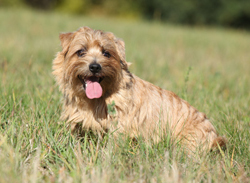Norfolk Terriers are small dogs with weather resistant, wiry coats that are close lying. They come in wheaten, grizzle, red, and black and tan, and they are known for their drop ears. There is a ruff of hair at the throat and base of the ears, and these dogs have whiskers and slight eyebrows. They have small, dark eyes and strong muzzles. Norfolk Terriers measure 9 to 10 inches tall at the shoulder and weigh 11 to 12 pounds.
These dogs are highly adaptable and do equally well in city apartments and in rural homes.
Loyal, charming, and active dogs, Norfolk Terriers get along with other animals and with children, making them a good choice for families. These dogs are highly adaptable and do equally well in city apartments and in rural homes. They are affectionate and enjoy spending time with their family members.
Because the Norfolk Terrier is so often confused with its closely related relative, the Norwich Terrier, a special trick was developed to remember which is which. The Norfolk's drop ears FOLD forward toward the head, while the Norwich has ears that point upward, like the hat of a WITCH.
Norfolk Terriers are energetic, affectionate, and loyal dogs that love spending time with their family members. They are inquisitive and clever, and they like to dig, hunt, and investigate new sights, sounds, and smells. For their own safety, they should be contained in a securely fenced yard when not on a leash.
These even-tempered dogs make excellent companion animals for families with children and other pets. They tend to become very attached to their loved ones and do not enjoy being left alone for long periods. Norfolk Terriers are feisty, amiable, and believe themselves to be much larger than they really are. For this reason, they need supervision when around large and unfamiliar dogs.
A naturally active breed, the Norfolk Terrier requires regular walks and play sessions to remain physically and mentally healthy. These dogs may be perfectly sized for lapdogs, but they will never be truly happy in that role.
Norfolk Terriers are a generally healthy breed affected by few health conditions. Patellar luxation is known to occasionally cause problems in the breed, and obesity can become an issue without regular exercise and attention to portion sizes at meals.
The most serious health concern in this breed is mitral valve disease, a potentially fatal condition that causes heart failure. An estimated 60 percent of Norfolk Terriers in America show evidence of mitral valve degeneration, according to a 2000 study of members of the American Norfolk Terrier Association and Norwich and Norfolk Terrier Club.
With regular exercise, a healthy diet, and routine veterinary care, Norfolk Terriers typically live 12 to 15 years.
An easy-to-train breed, Norfolk Terriers respond well to clear and consistent commands and positive reinforcement, including play, food, and praise rewards. Having said that, patience is key when it comes to training this breed. If these dogs aren't having fun, they can be stubborn and resistant. The good news is that these dogs are easier than most other small breeds to housetrain.
Norfolk Terriers tend to develop destructive behavior if neglected or ignored. This usually takes the form of digging or barking, and both can get out of hand quickly. Obedience training combined with regular attention and plenty of affection should prevent problem behaviors in this breed.
Early socialization helps ensure these dogs grow into tolerant adults. Ideally, the breed should be exposed to a variety of sights, sounds, and people early in life. Puppy kindergarten is a good idea, and regular trips to neighborhood stores and the dog park is beneficial later in life.
Norfolk Terriers require regular grooming, which means daily brushing to control shedding. A careful combing once or twice weekly and professional stripping of dead hairs every few months is also necessary. If stripping is not practical, dogs not intended for show can be clipped regularly instead.
Bathing is rarely necessary and should only be done to remove a harmful or sticky substance from the coat. This is because soap can reduce the weatherproofing properties of the Norfolk Terrier's coat.
The nails should be trimmed every few weeks to prevent snags and breaks, and the ears should be checked weekly for signs of wax accumulation and infection. Redness, odor, discharge, and other signs of infection require prompt veterinary attention. Like other small dogs, the Norfolk Terrier is at increased risk for periodontal disease. The teeth need daily brushing and routine checkups to prevent gum disease and tooth loss.
Norfolk Terriers are native to England and were developed for use as ratters in barns and to scare fox and other small animals from their dens. These dogs were so talented in this role that students at Cambridge University, which is located in the area of England where the breed originated, would bet on the ratting abilities of these dogs. Back then, the breed was known as Trumpington Terriers.
Following World War II, Norfolk Terriers nearly became extinct. Fortunately, dedication to the breed prevented this from happening. They were originally considered the same breed as what is now called the Norwich Terrier, but the dogs were separated into two distinct breeds in 1979. Dogs with drop ears became known as Norfolk Terriers, while those with prick ears became known as Norwich Terriers.
Today, Norfolk Terriers are popular companion animals, but they remain less desirable for show than Norwich Terriers.
The American Kennel Club officially recognized the Norfolk Terrier in 1979.

